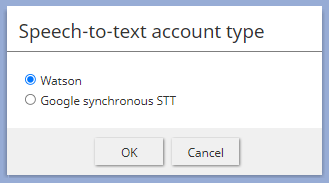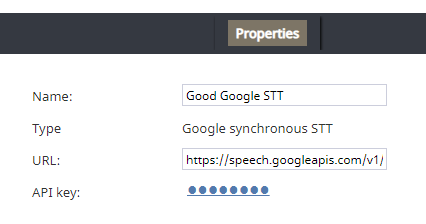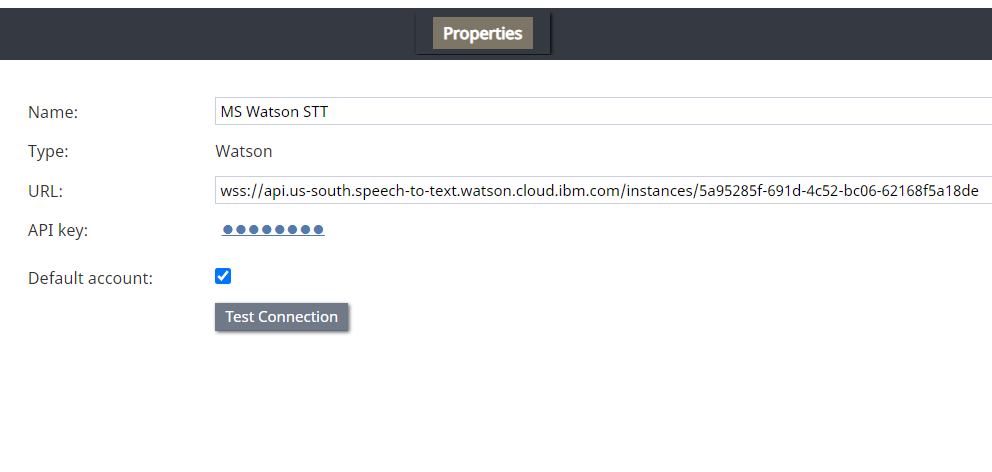imported>Sergem |
(Updated via BpDeleteTranslateTags script) |
||
| Line 1: | Line 1: | ||
| − | + | = Speech To Text Integration (STT) = | |
Speech To Text (STT) integration allows your contact center to use speech-to-text functionality to transcribe voice calls and save the transcriptions to interaction records. Full-text transcripts are searchable and include sentiment attributes (if Natural Language Understanding is enabled). | Speech To Text (STT) integration allows your contact center to use speech-to-text functionality to transcribe voice calls and save the transcriptions to interaction records. Full-text transcripts are searchable and include sentiment attributes (if Natural Language Understanding is enabled). | ||
| − | |||
Bright Pattern integrates with STT providers such as IBM Watson and Google. | Bright Pattern integrates with STT providers such as IBM Watson and Google. | ||
| − | |||
[[File:CCA-CCC-IA-STT-New-Integration-Window-5599may2021.PNG|800px|thumbnail|center|Select the type of STT integration]] | [[File:CCA-CCC-IA-STT-New-Integration-Window-5599may2021.PNG|800px|thumbnail|center|Select the type of STT integration]] | ||
| − | == Google Properties == | + | == Google Properties == |
Google's Cloud Speech API converts audio to text. In the Properties dialog, enter the credentials of your Google synchronous STT instance as follows. This allows Bright Pattern to access your STT resource and use it in interactions. | Google's Cloud Speech API converts audio to text. In the Properties dialog, enter the credentials of your Google synchronous STT instance as follows. This allows Bright Pattern to access your STT resource and use it in interactions. | ||
| − | |||
Please note: Google STT requires a payment method to be attached to the account; without this, the STT service would silently not work, and there would be an error in the Google API dashboard. | Please note: Google STT requires a payment method to be attached to the account; without this, the STT service would silently not work, and there would be an error in the Google API dashboard. | ||
| − | |||
[[File:Google-STT-Properties-53.PNG|800px|thumbnail|center|Google synchronous STT integration account properties]] | [[File:Google-STT-Properties-53.PNG|800px|thumbnail|center|Google synchronous STT integration account properties]] | ||
| − | === Name === | + | === Name === |
The unique name of this integration account (any) | The unique name of this integration account (any) | ||
| − | === Type === | + | === Type === |
By default, “Google synchronous STT” because you selected this type when adding the account. | By default, “Google synchronous STT” because you selected this type when adding the account. | ||
| − | === Use phone model === | + | === Use phone model === |
When enabled, ''Use phone model'' allows you to use the Cloud Speech API’s [https://cloud.google.com/speech-to-text/docs/enhanced-models enhanced model for phone calls]; the setting may be useful for [[Tutorials-for-admins/Voice/ConversationalIVRConfiguration|conversational IVR scenarios]]. Note that this setting is disabled by default. | When enabled, ''Use phone model'' allows you to use the Cloud Speech API’s [https://cloud.google.com/speech-to-text/docs/enhanced-models enhanced model for phone calls]; the setting may be useful for [[Tutorials-for-admins/Voice/ConversationalIVRConfiguration|conversational IVR scenarios]]. Note that this setting is disabled by default. | ||
| − | === URL === | + | === URL === |
By default, https://speech.googleapis.com/v1/ | By default, https://speech.googleapis.com/v1/ | ||
| − | === API key === | + | === API key === |
The service key ID that is used to authenticate Google's Cloud Speech API. This is generated when you get credentials for your service account. | The service key ID that is used to authenticate Google's Cloud Speech API. This is generated when you get credentials for your service account. | ||
| − | === Test Connection === | + | === Test Connection === |
Click to be sure Bright Pattern Contact Center can connect to your Google synchronous STT account. | Click to be sure Bright Pattern Contact Center can connect to your Google synchronous STT account. | ||
| − | == Watson Properties == | + | == Watson Properties == |
In the Properties dialog, enter the credentials of your IBM Watson STT instance as follows. This allows Bright Pattern to access your STT resource and use it in interactions. | In the Properties dialog, enter the credentials of your IBM Watson STT instance as follows. This allows Bright Pattern to access your STT resource and use it in interactions. | ||
| − | |||
[[File:Watson-STT-Properties-5399.PNG|800px|thumbnail|center|Watson integration account properties]] | [[File:Watson-STT-Properties-5399.PNG|800px|thumbnail|center|Watson integration account properties]] | ||
| − | === Name === | + | === Name === |
The name of this integration account. | The name of this integration account. | ||
| − | === Type === | + | === Type === |
By default, “Watson” because you selected this type when adding the account. | By default, “Watson” because you selected this type when adding the account. | ||
| − | === URL === | + | === URL === |
Websocket prefix + your IBM Speech to Text URL in the following format: | Websocket prefix + your IBM Speech to Text URL in the following format: | ||
| − | |||
For example: | For example: | ||
| − | |||
'''wss://api.us-south.speech-to-text.watson.cloud.ibm.com/instances/1a23456f-121d-4c52-bc06-62168f5a18de''' | '''wss://api.us-south.speech-to-text.watson.cloud.ibm.com/instances/1a23456f-121d-4c52-bc06-62168f5a18de''' | ||
| − | |||
You can find the URL in your IBM Speech to Text service credentials. Note that STT integration uses the secure WebSocket protocol (i.e., "wss"), so only the wss:// prefix is allowed. | You can find the URL in your IBM Speech to Text service credentials. Note that STT integration uses the secure WebSocket protocol (i.e., "wss"), so only the wss:// prefix is allowed. | ||
| − | === API key === | + | === API key === |
The API key (string) for the service instance in your IBM Speech to Text resource, which is used for making secure, authenticated requests. | The API key (string) for the service instance in your IBM Speech to Text resource, which is used for making secure, authenticated requests. | ||
| − | |||
You can find your API key on IBM Cloud by going to your Speech to Text service credentials. | You can find your API key on IBM Cloud by going to your Speech to Text service credentials. | ||
| − | === Default account === | + | === Default account === |
Select the ''Default account'' checkbox to enable the STT integration account. | Select the ''Default account'' checkbox to enable the STT integration account. | ||
| − | === Test Connection=== | + | === Test Connection=== |
Click to be sure Bright Pattern Contact Center can connect to your Watson Speech to Text account. | Click to be sure Bright Pattern Contact Center can connect to your Watson Speech to Text account. | ||
| − | |||
| − | |||
| − | |||
| − | |||
| − | |||
| − | |||
Latest revision as of 04:12, 29 May 2024
Speech To Text Integration (STT)
Speech To Text (STT) integration allows your contact center to use speech-to-text functionality to transcribe voice calls and save the transcriptions to interaction records. Full-text transcripts are searchable and include sentiment attributes (if Natural Language Understanding is enabled).
Bright Pattern integrates with STT providers such as IBM Watson and Google.
Google Properties
Google's Cloud Speech API converts audio to text. In the Properties dialog, enter the credentials of your Google synchronous STT instance as follows. This allows Bright Pattern to access your STT resource and use it in interactions.
Please note: Google STT requires a payment method to be attached to the account; without this, the STT service would silently not work, and there would be an error in the Google API dashboard.
Name
The unique name of this integration account (any)
Type
By default, “Google synchronous STT” because you selected this type when adding the account.
Use phone model
When enabled, Use phone model allows you to use the Cloud Speech API’s enhanced model for phone calls; the setting may be useful for conversational IVR scenarios. Note that this setting is disabled by default.
URL
By default, https://speech.googleapis.com/v1/
API key
The service key ID that is used to authenticate Google's Cloud Speech API. This is generated when you get credentials for your service account.
Test Connection
Click to be sure Bright Pattern Contact Center can connect to your Google synchronous STT account.
Watson Properties
In the Properties dialog, enter the credentials of your IBM Watson STT instance as follows. This allows Bright Pattern to access your STT resource and use it in interactions.
Name
The name of this integration account.
Type
By default, “Watson” because you selected this type when adding the account.
URL
Websocket prefix + your IBM Speech to Text URL in the following format:
For example:
wss://api.us-south.speech-to-text.watson.cloud.ibm.com/instances/1a23456f-121d-4c52-bc06-62168f5a18de
You can find the URL in your IBM Speech to Text service credentials. Note that STT integration uses the secure WebSocket protocol (i.e., "wss"), so only the wss:// prefix is allowed.
API key
The API key (string) for the service instance in your IBM Speech to Text resource, which is used for making secure, authenticated requests.
You can find your API key on IBM Cloud by going to your Speech to Text service credentials.
Default account
Select the Default account checkbox to enable the STT integration account.
Test Connection
Click to be sure Bright Pattern Contact Center can connect to your Watson Speech to Text account.



